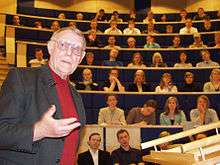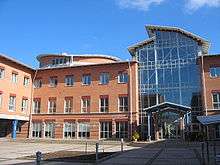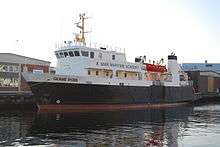Linnaeus University
Linnaeus University (LNU) (Swedish: Linnéuniversitetet) is a state university in the Småland region of Sweden. It has two campuses, one in Växjö and one in Kalmar. Linnaeus University was established in 2010 by a merger of former Växjö University and Kalmar University (Högskolan i Kalmar), and is named in honour of the Swedish botanist Carl Linnaeus.[1]
Linnéuniversitetet | |
| Latin: Universitas Linnæus | |
Former names | Växjö Universitet (1999-2009)
Högskolan i Växjö (1977-1999) Högskolan i Kalmar (1977-2009) |
|---|---|
| Type | Public university |
| Established | 2010 (1967) |
| Endowment | SEK 1.5 billion |
| Budget | 1761 Mkr (2016)[1] |
| Rector | Peter Aronsson |
Academic staff | 2,000[1] |
| Students | 15,000 FTE[1] |
| 302 (F167+M135) | |
| Location | , , |
| Campus | Urban |
| Affiliations | EUA, SUHF |
| Website | lnu.se |

History
Växjö University began as a local department of Lund University in 1967. The department became an independent university college in 1970, and was granted full university status in 1999.
Kalmar University was similarly a university college, founded in 1977. Though not a university by the Swedish definition, it had been entitled to issue doctoral degrees in the natural sciences since 1999.
Logo
The university's logo is a stylized tree. The origin is a drawing made by the Swedish scientist Carl Linnaeus taken from his 1725 publication Örtabok.[2] While the tree is said to be a symbol for the month of May and to represent the power of growth, it also symbolize the university's ambition to be a global university with the region as its base and the world as its arena.


Faculties and schools
Faculties
- Faculty of arts and humanities.
- Faculty of health and life sciences.
- Faculty of social sciences.
- Faculty of technology.
- School of business and economics.
- Board of teacher education.
Departments
- Department of Accounting and Logistics
- Department of Biology and Environmental Science
- Department of Building Technology
- Department of Built Environment and Energy Technology
- Department of Chemistry and Biomedical Sciences
- Department of Computer Science and Media Technology
- Department of Design
- Department of Economics and Statistics
- Department of Education and Teachers' Practice
- Department of Film and Literature
- Department of Forestry and Wood Technology
- Department of Health and Caring Sciences
- Department of Informatics
- Department of Languages
- Department of Marketing
- Department of Mathematics
- Department of Mechanical Engineering
- Department of Media and Journalism
- Department of Medicine and Optometry
- Department of Music and Art
- Department of Organisation and Entrepreneurship
- Department of Pedagogy and Learning
- Department of Physics and Electrical Engineering
- Department of Political Science
- Department of Psychology
- Department of Social Studies
- Department of Social Work
- Department of Sport Science
- Department of Swedish
- Kalmar Maritime Academy
Other institutes
- Institute for Further Education of Journalists
- Institute of Police Education
- Centre for Gender Studies
- Centre for School Development and Educational Leadership
University Administration
- Communications Office
- Executive Office
- Finance Office
- IT Office
- Office of External Relations
- Office of Facilities Management and Services
- Office of Human Resources
- Office of Student Affairs
- University Library
Campus
There are two campuses, one in Växjö and one in Kalmar.[1]
Kalmar
Kalmar is a medium-sized town, with ideal settings for student life. The town is attractive and conveniently laid out, with a colorful history and a castle dating back to medieval times, close proximity to the sea, undulating farmlands and deep forests. The Department of Biology and Environmental Science in Kalmar has special competence in the area of life, health and the environment and is recognized for excellence in teaching and research across a range of natural sciences and related disciplines. The School offers Master’s programmes which equip the graduate for work in industry or future studies towards a PhD.
Växjö
Växjö, is a central community in the south of Sweden, with a full range of cultural and musical life in its many museums, theaters, cathedrals and concert halls. The House of Emigrants commemorates the great emigration epoch from 1850 to 1930, when 1.3 million Swedes emigrated to America. The region is also known for its high tech industry, pulp and paper manufacturing, and home of the furniture manufacturer, IKEA. The surrounding pristine lakes and forests are an attraction for those who love wildlife and the outdoors. Växjö has also been one of the leading tennis cities in the world as Mats Wilander, Stefan Edberg, Magnus Larsson and Jonas Bjorkman have all trained and played here. Växjö is easily accessible from Copenhagen and Stockholm by plane and train.
The campus is located just outside Växjö city center. It was designed in the American campus style, meaning that all teaching premises are within walking distance. The campus was built with the environment in mind, for it borders a nature conservation area.
There are 3,700 student apartments and dorm rooms on the university campus housing approximately 4,600-5,200 students. A part of the university campus is dedicated to the Videum Science Park. The park gives space to over 100 companies, thus being in close proximity with the university and encouraging innovation and research.
Teaching premises and accommodation stand side by side on the campus. There are also restaurants, cafés, bars, a sports centre and a variety of service facilities. The campus offers a safe, relaxed environment despite the high level of activity. It is bordered by meadows, a nature conservation area, a lake with bird-watching towers, and Teleborg Castle.
New buildings have been erected with due concern for the environment, leaving room for old trees and moss-covered boulders among the new architecture on campus. Cars have only limited access to the site, but cycle paths lead directly to the town centre and out into the beautiful countryside all around.
Department of Biology and Environmental Science
The Department of Biology and Environmental Science is part of the Faculty of Health and Life Sciences. Scientists working at the department are involved in research and teaching activities in Biology, Biomedical Science, Pharmacy, Chemistry, Food Science and Environmental Science. Most of the research laboratories and classes are operated in Kalmar. It offers seven Bachelor programs (in Swedish) and four Master programs.
A non-comprehensive list of the research group operating with the school include:
- Applied biochemistry research group (Prof. Sten Ohlson)
- Bioorganic and Biophysical Chemistry Laboratory (Prof. Ian A. Nicholls)
- Nutrient sensing and phosphate transport in ''Saccharomyces cerevisiae''. Biochemistry Research Group (Prof. Bengt Persson)
- Computational Chemistry and Biochemistry Research Group (Dr. Ran Friedman)
- Environmental Engineering and Recovery Department (Prof. William Hogland)
- Marine Ecology Research Group (Prof. Edna Graneli)
- Plant Biochemistry/Plant Biotechnology Research Group (Prof.Peter Brodelius)
- Virology Research Group (Prof. Michael Lindberg)
- Zoonotic Ecology Research Group (Dr. Jonas Waldenström)
Notable alumni
- Rolph Payet - Seychellois Cabinet Minister
- Kevin Falk - American physician
- Malik Bendjelloul - Director of Academy Award-winning documentary Searching for Sugar Man[3]
See also
- List of universities in Sweden
References
- "Linnéuniversitetet". Nationalencyklopedin (in Swedish). Retrieved 17 September 2010. (subscription required)
- "Symbol". Linnaeus University. Archived from [view-source:https://medarbetare.lnu.se/stod-och-service/kommunikation-och-marknadsforing/designmanual/grundelement/symbol the original] Check
|url=value (help) on 30 May 2016. Retrieved 12 April 2016. - Weber, Bruce (2014-05-13). "Malik Bendjelloul, Oscar Winner for 'Sugar Man' Film, Dies at 36". The New York Times.
External links
| Wikimedia Commons has media related to Linnaeus University. |
- Linnaeus University - official site
- VIS - official site